AMD's Radeon HD 6970 & Radeon HD 6950: Paving The Future For AMD
by Ryan Smith on December 15, 2010 12:01 AM ESTPower, Temperature, & Noise
Last but not least as always is our look at the power consumption, temperatures, and acoustics of the Radeon HD 6900 series. This is an area where AMD has traditionally had an advantage, as their small die strategy leads to less power hungry and cooler products compared to their direct NVIDIA counterparts. However NVIDIA has made some real progress lately with the GTX 570, while Cayman is not a small die anymore.
AMD continues to use a single reference voltage for their cards, so the voltages we see here represent what we’ll see for all reference 6900 series cards. In this case voltage also plays a big part, as PowerTune’s TDP profile is calibrated around a specific voltage.
| Radeon HD 6900 Series Load Voltage | ||||
| Ref 6970 | Ref 6950 | 6970 & 6950 Idle | ||
| 1.175v | 1.100v | 0.900v | ||
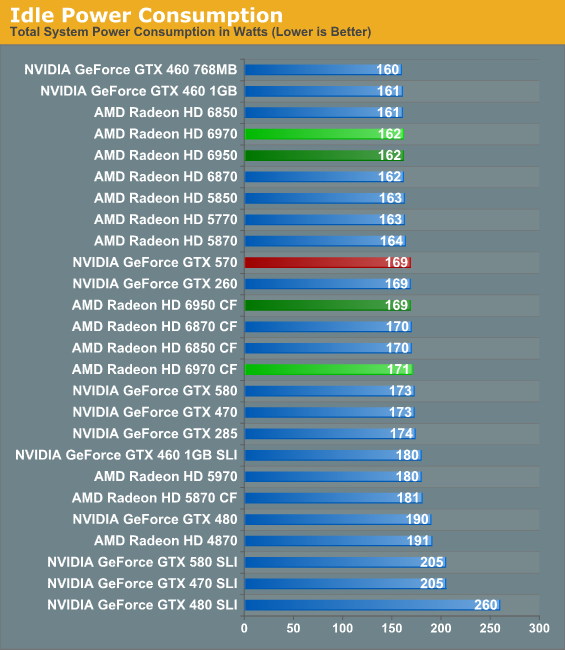
As we discussed at the start of our look at these cards, AMD has been tweaking their designs to take advantage of TSMC’s more mature 40nm process. As a result they’ve been able to bring down idle power usage slightly, even though Cayman is a larger chip than Cypress. For this reason the 6970 and 6950 both can be found at the top of our charts, running into the efficiency limits of our 1200W PSU.
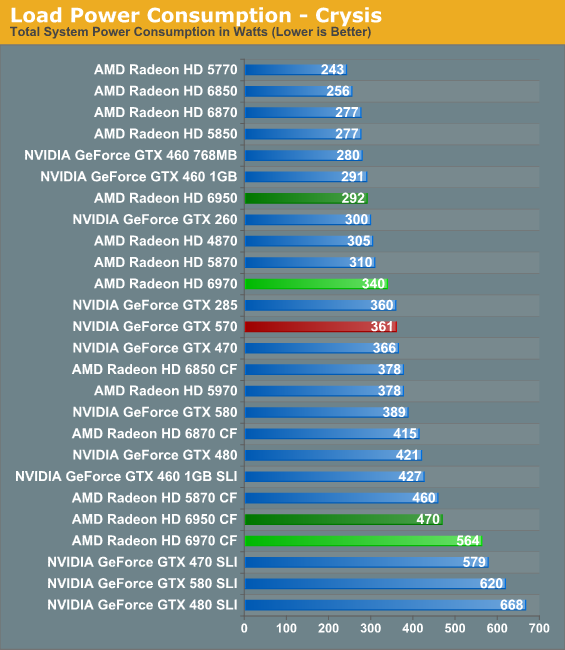
Under Crysis PowerTune is not a significant factor, as Crysis does not generate enough of a load to trigger it. Accordingly our results are rather straightforward, with the larger, more power hungry 6970 drawing around 30W more than the 5870. The 6950 meanwhile is rated 50W lower and draws almost 50W less on the dot. At 292W it’s 15W more than the 5850, or effectively tied with the GTX 460 1GB.
Between Cayman’s larger die and NVIDIA’s own improvements in power consumption, the 6970 doesn’t end up being very impressive here. True, it does draw 20W less, but with the 5000 series AMD’s higher power efficiency was much more pronounced.
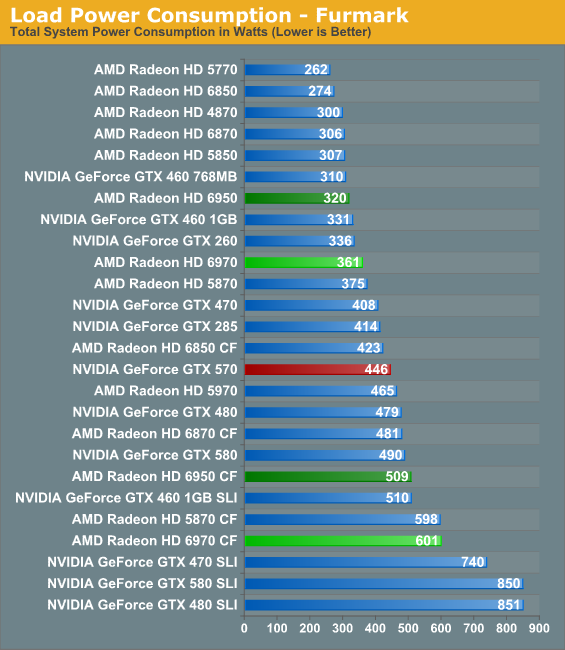
It’s under FurMark that we finally see the complete ramifications of AMD’s PowerTune technology. The 6970, even with a TDP over 60W above the 5870, still ends up drawing less power than the 5870 due to PowerTune throttling. This puts our FurMark results at odds with our Crysis results which showed an increase in power usage, but as we’ve already covered PowerTune tightly clamps power usage to AMD’s TDP, keeping the 6900 series’ worst case scenario for power consumption far below the 5870. While we could increase the TDP to 300W we have no practical reason to, as even with PowerTune FurMark still accurately represents the worst case scenario for a 6900 series GPU.
Meanwhile at 320W the 6950 ends up drawing more power than its counterpart the 5850, but not by much. It’s CrossFire variant meanwhile is drawing 509W,only 19W over a single GTX 580, driving home the point that PowerTune significantly reduces power usage for high load programs such as FurMark.
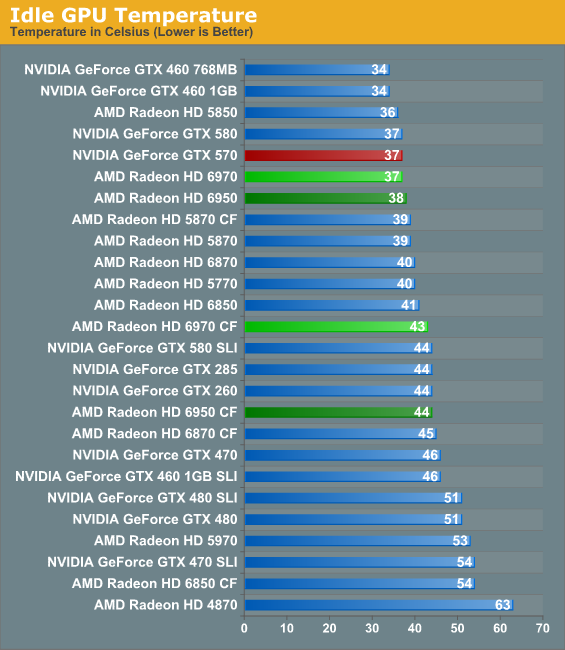
At idle the 6900 series is in good company with a number of other lower power and well-built GPUs. 37-38C is typical for these cards solo, meanwhile our CrossFire numbers conveniently point out the fact that the 6900 series doesn’t do particularly well when its cards are stacked right next to each other.
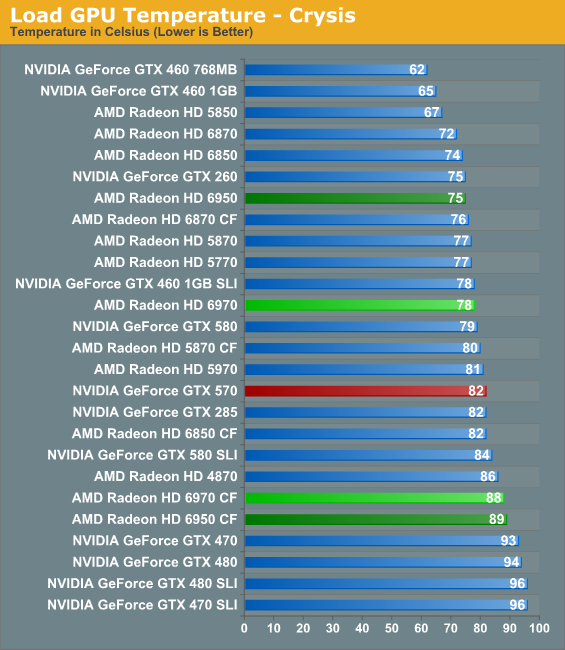
When it comes to Crysis our 6900 series cards end up performing very similarly to our 5800 series cards, a tradeoff between the better vapor chamber cooler and the higher average power consumption when gaming. Ultimately it’s going to be noise that ties all of this together, but there’s certainly nothing objectionable about temperatures in the mid-to-upper 70s. Meanwhile our 6900 series CF cards approach the upper 80s, significantly worse than our 5800 series CF cards.
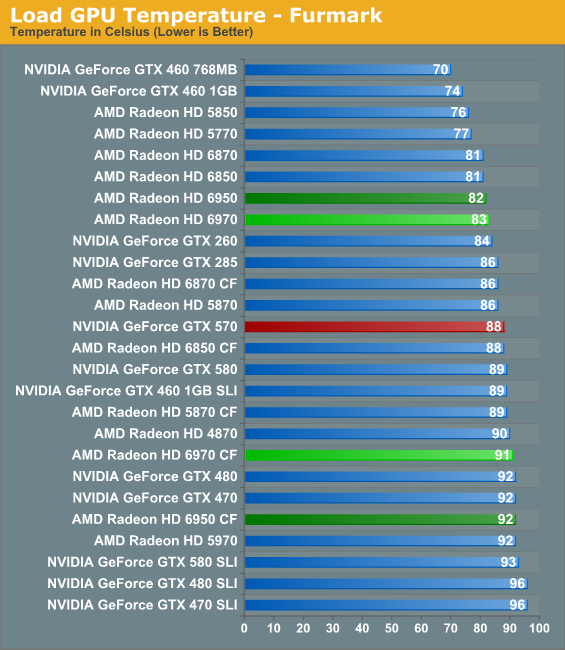
Faced once more with FurMark, we see the ramifications of PowerTune in action. For the 6970 this means a temperature of 83C, a few degrees better than the 5870 and 5C better than the GTX 570. Meanwhile the 6950 is at 82C in spite of the fact that it uses a similar cooler in a lower powered configuration; it’s not as amazing as the 5850, but it’s still quite reasonable.
The CF cards on the other hand are up to 91C and 92C despite the fact that PowerTune is active. This is within the cards’ thermal range, but we’re ready to blame the cards’ boxy design for the poor CF cooling performance. You really, really want to separate these cards if you can.
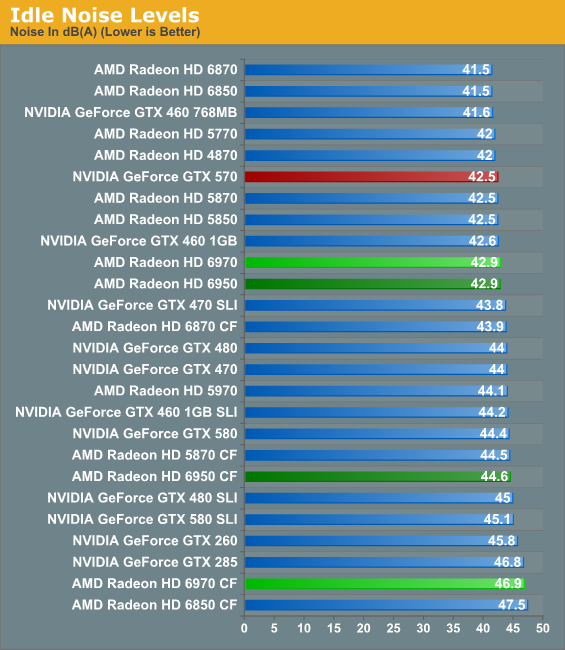
At idle both the 6970 and 6950 are on the verge of running in to our noise floor. With today’s idle power techniques there’s no reason a card needs to have high idle power usage, or the louder fan that often leads to.

Last but not least we have our look at load noise. Both cards end up doing quite well here, once more thanks to PowerTune. As is the case with power consumption, we’re looking at a true worst case scenario for noise, and both cards do very well. At 50.5db and 54.6db neither card is whisper quiet, but for the gaming performance they provide it’s a very good tradeoff and quieter than a number of slower cards. As for our CrossFire cards, the poor ventilation pours over in to our noise tests. Once more, if you can separate your cards you should do so for greatly improved temperature and noise performance.










168 Comments
View All Comments
Roland00Address - Wednesday, December 15, 2010 - link
1) The architecture article is something that can be written before hand, or written during benching (if the bench is on a loop). It has very little "cramming" to get out right after a NDA ends. Anand knows this info for a couple of weeks but can't discuss it due to NDAs. Furthermore the reason anandtech is one of the best review sites on the net is the fact they do go into the architecture details. The architecture as well as the performance benchmarks is the reason I come to anandtech instead of other review sites as my first choice.2) The spelling and grammar errors is a common thing at anandtech, this is nothing new. That said I can't complain for my spelling and grammar is far worse than Ryan's.
If you don't like the style of the review go somewhere else.
Ryan Smith - Wednesday, December 15, 2010 - link
1) That's only half true. AMD told us the basics about the 6900 series back in October, but I never had full access to the product information (and more importantly the developers) until 1 week ago. So this entire article was brought up from scratch in 1 week.It's rare for us to get too much access much earlier than that; the closest thing was the Fermi launch where NVIDIA was willing to talk about the architecture months in advance. Otherwise that's usually a closely held secret in order to keep the competition from having concrete details too soon.
Dracusis - Wednesday, December 15, 2010 - link
Neither the AMD 6xxx series or Nvidia's 5xx series have been added. Would like to see how my 4870x2 stack up against this latest generation and weather or not it's worth upgrading.Makaveli - Wednesday, December 15, 2010 - link
The Canadian pricing on these cards are hilarious.Ncix is taking preorder for the 6970 at $474.
While they sell the 570 for $379.
Can someone explain to me why I would pay $100 more for the radeon when the 570 gives equal performance?
Are these retailers that retarded?
stangflyer - Thursday, December 16, 2010 - link
They will price the 6950/6970 high for a few days to get the boys that bleed red and have to have the new cards right away to pay top dollar for the card.After a week they will probably be about the same price.
Ryan Smith - Thursday, December 16, 2010 - link
Bench will be up to date by the start of next week.Paladin1211 - Thursday, December 16, 2010 - link
Whats wrong with you rarson? Do you even know whats the difference between "Graphics card review", "Performance review", "Performance Preview"? I dont know how good your grammar and spelling are, but they dont matter as long as you cant understand the basic meaning of the words.Most of the sites will tell you about WHAT, but here at AnandTech, you'll truly find out WHY and HOW. Well, of course, you can always go elsewhere try to read some numbers instead of words.
Keep up the good works, Ryan.
Belard - Thursday, December 16, 2010 - link
The 3870 and 3850 were the TOP end for ATI, as was the 4800 and the 5800. Their relationship of model numbers do not have anything to do with the status of Nvidia.When the 3870 was brand new, what was the HIGHEST end card ATI had back then? Oh yeah, the 3870!
4800 is over the 3870, easily.
4600 replaced the 3800
The 5800s replaces the 4800s... easily.
the 5700s kind of replaced the 4800s.
The 6800s replaces the 5700 & 5800s, the 6900s replace the 5800s, but not so much on performance.
I paid $90 for my 4670 and a much better value than the $220 3870 since both cards perform almost the same.
AmdInside - Thursday, December 16, 2010 - link
I can't think of a single website that has better hardware reviews, at least for computer technology than Anandtech. Ryan, keep up the great work.George.Zhang - Thursday, December 16, 2010 - link
BTW, HD6950 looks great and affordable for me.